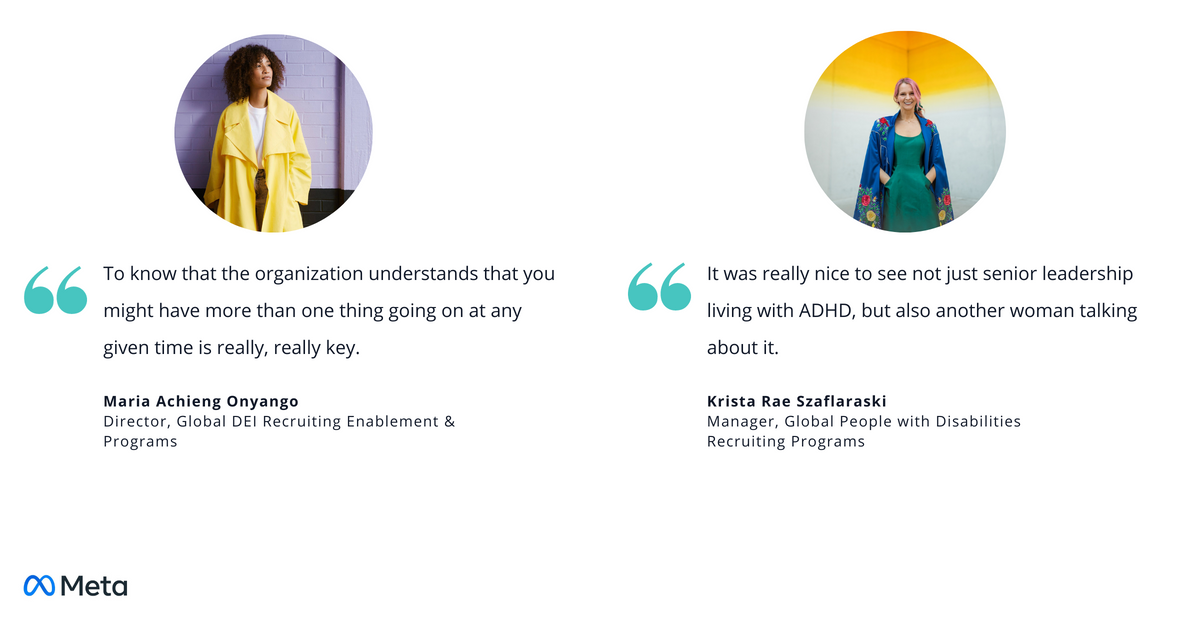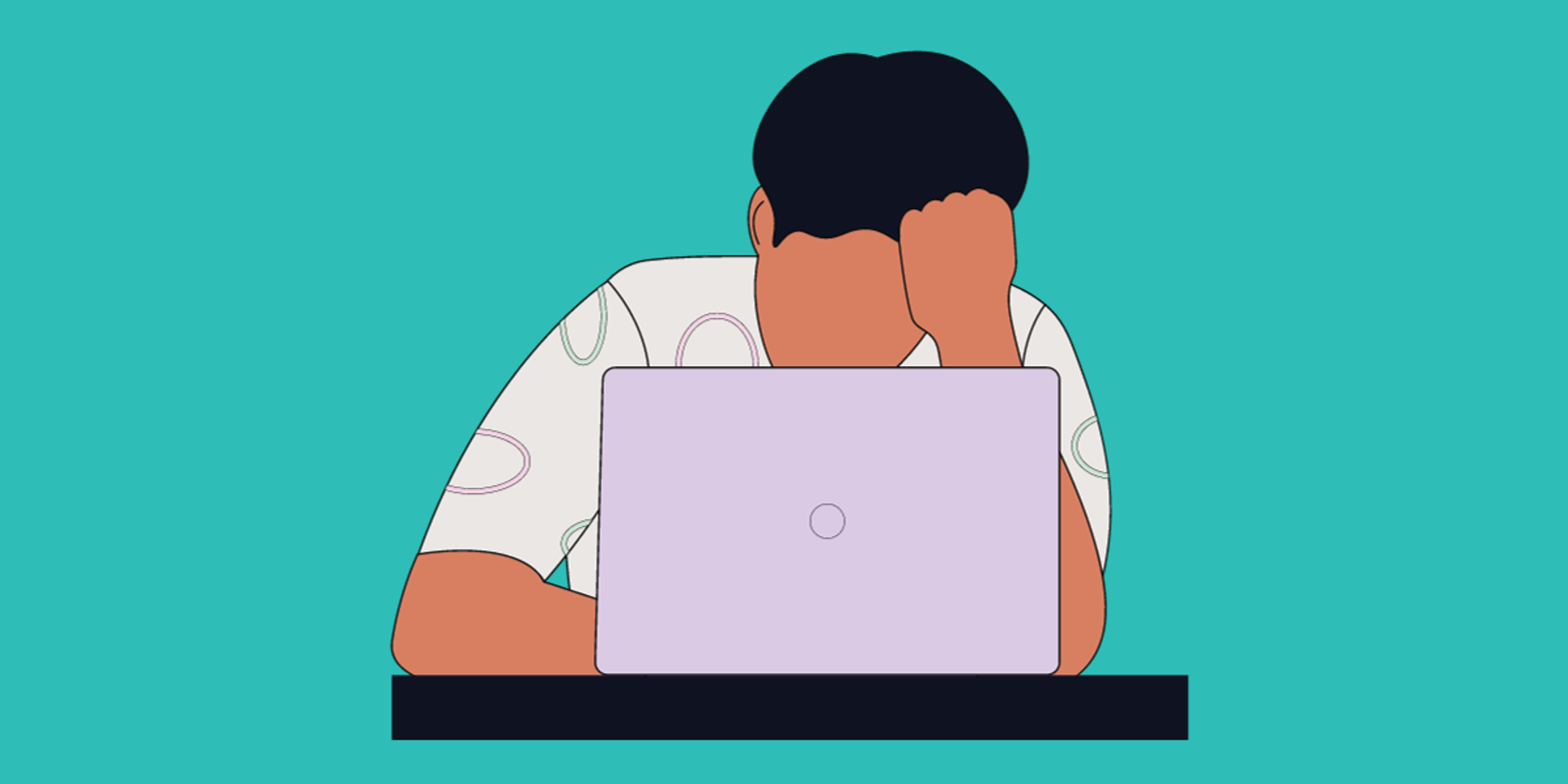Meet Meta’s Krista Rae Szaflaraski (Manager, Global People with Disabilities Recruiting Programs, based in Austin, Texas) and Maria Achieng Onyango (Director, Global DEI Recruiting Enablement & Programs, based in London, UK). Krista Rae and Maria are passionate about disability awareness and champions of inclusivity at Meta.
As women with ADHD diagnoses, they’ve both been through the - often challenging - process of getting diagnosed as adults and learning to navigate their careers through a new lens. But beyond their diagnoses, they have also tackled the nuances of their various identities — from being women to mothers to immigrants, and more.
During our Visible & Invisible Disabilities & Neurodivergence Summit, we sat down with Krista Rae and Maria for a coffee chat about disability through an intersectional lens or, as Krista puts it, “Just the kind of stuff we like to talk about!”
Experiences with ADHD
“I was diagnosed at 33,” Maria shares, reflecting on the moment that transformed both her view of herself and the world. “I don't think it's that late in life, but for a diagnosis like ADHD, it is later than most people are diagnosed. And it certainly came at a time when more women were being diagnosed.
I think back to me as an eight-year-old in Kenya, and I just don't think it was on the radar. And then as a 12-year-old in an all-girls secondary school that was very, very focused on academia, the conversations around mental health and neurodiversity just didn't happen.”
Krista also received her ADHD diagnosis as an adult.
“When I went through my diagnosis, they had to call my mother and have her on the line because they explained they don't have an adult version of the ADHD test,” she shared. “A lot of times, these tests have been focused on what you're like as a child, and having my mom there was just fascinating.”
Both women agree on how difficult it was to navigate their career growth while managing the symptoms of ADHD — this is known as masking: hiding symptoms and acting in a “socially acceptable” way to fit in and form better connections with others. And even when they were able to do so, the emotional and psychological costs of trying to conform often came at a high price.
“I had my son when I was 22, and I just focused on him,” says Maria. “I knew that I was the least organized person in the world. I knew I had to get my act together. I knew I was still growing up.”
Maria shares how, in caring for her son, she ended up neglecting many of her own needs, including missing every single dentist appointment over four years.
“My son, on the other hand, has been to every single appointment every six months since he was three years old. So even in that context, it's absolutely possible for people with ADHD to focus on the most important things and to prioritize, but often at the expense of the basic things that you should be doing for yourself.”
Viewing disability through an intersectional lens
As a biracial woman, Maria also explored how her multiple identities coexist, and what that might mean for others.
“I think generally in the UK, young Black kids are more likely to be seen as disruptive rather than people thinking, ‘Oh, there might be something else going on here’,” she comments. “So gender, race, and then also presenting with other mental health issues can kind of lead to adults crossing ADHD off the list, particularly if you're masking.
If you are academically able (for example, if you’re able to crush your natural instinct for an hour and get through a lesson) there's a lot that goes on behind that mask.” — a lot that others might not recognize. The ability to mask neurodiverse conditions may delay or sabotage diagnosis. In turn, internalized conditions including anxiety or depression, might develop as a consequence of undiagnosed, untreated, and hidden neurodiverse conditions.
Maria also believes that many medical systems lack an intersectional lens during the process of diagnosis.
“There is a failure of healthcare provision for people that don't fit the mold,” she explains. “The current DSM-5 criteria for ADHD was built with a 12-year-old Caucasian boy in mind, right? That's what it's describing. So I think medical professionals are more likely to diagnose women and Black women with more stereotypical: diagnoses like depression.”
The DSM-5, the medical diagnostic criteria for ADHD, was first developed in 1980, when the ratio of boys to girls diagnoses was 25:1. And, the symptom threshold or “cutoff” for a diagnosis of ADHD was based on field trials that included more boys than girls.
Today, Maria looks back at many of her childhood systems and recognizes the presence of ADHD. But, her doctors never could.
“Despite me having a lot of contact with psychotherapists and psychiatrists, none of them ever thought that there might be an underlying cause [for my issues], and it was never understood why medication for depression didn't necessarily work,” she says. “I was in front of the medical community pretty regularly from the age of 10 to probably about 22, and yet it was never picked up.”
The journey to acceptance
After getting her diagnosis, Maria’s next step was to figure out how this was going to impact her work life.
“I spoke to my diagnosing psychiatrist about the pros and cons of being open with Meta about it,” she says. After much thought, she decided to talk to the human resources department as well as her manager at the time.
Their response was a welcome relief.
“I sent this long email saying I don't need any accommodations because the way that we work here at Meta is already quite good. We document everything and meetings are recorded. But the team came back and still wanted to offer accommodations,” Maria explains with a smile.
Her manager allowed her to open up to the rest of the team at her own pace, and she was inundated by supportive feedback. To this, Krista remarks, “Fun fact, Maria is my manager. Her openness allowed me to learn more and start opening up and talking about my diagnosis. It was really nice to see not just senior leadership living with ADHD, but also another woman talking about it. I know that [Maria’s openness] has made a huge impression on a lot of folks.”
3 ways to apply an intersectional lens on disability
Maria leaves us with a few suggestions on how we can implement an intersectional lens when viewing disability and, in turn, better support all employees in the workplace.
- Understand that your teams represent various identities: “I would encourage folks to look at their pillars. It could be ethnicity, gender, LGBTQIA+, etc. And even within those groups, you have people that have such different experiences from each other. For example, within the Disability@ group here at Meta, we have a separate ADHD group because we have very specific things that we talk about. Being given that space and that allowance to have those conversations and to know that the organization understands that you might have more than one thing going on at any given time is really, really key.”
- Encourage involvement in more than one employee resource group: “Make sure that you are making provisions for employee resource groups so that employees can be part of more than one in a very meaningful way. I'm a member of Black@, Disability@, Women@, and ADHD@, and they all work together.”
- Allow voices of color to be heard across intersections: “Voices of color within the neurodivergent community have not always held a microphone. So, I think we have this responsibility as the ones building those communities to make sure that we include the perspectives of different voices to be able to bring that intersectionality of why your lived experience is different than my lived experience.”
To listen to the full conversation with Krista Rae Szaflaraski and Maria Achieng Onyango, watch the recording here. And if you’re interested in joining an organization that values an intersectional lens on disabilities, explore opportunities with Meta here.





